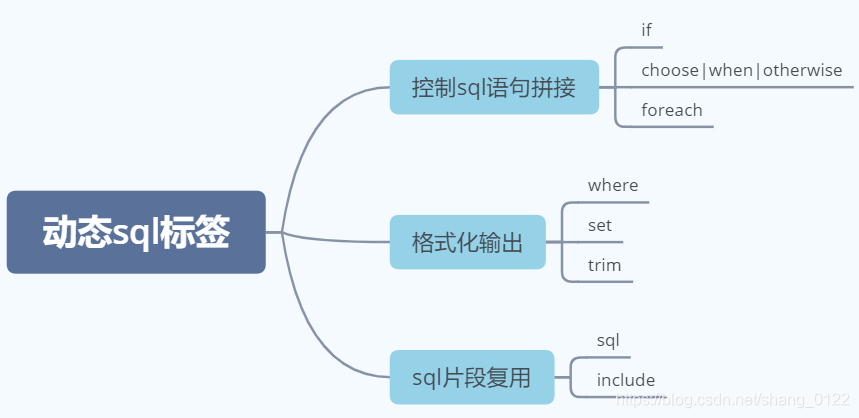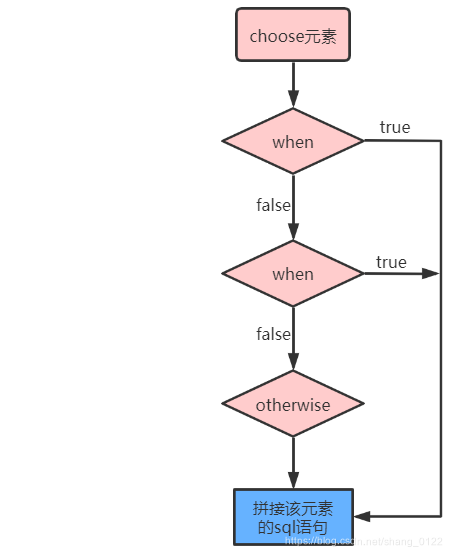写在前面 博客是我平时做项目和学习的过程,很基础,但是每一篇我很认真在写,力求让读者,读的清楚,看的明白。 不是大佬,但努力成为,如果您也对Java、算法感兴趣,可以相互关注,一起成长,相信滴水穿石的力量 动态sql是什么 动态sql作用 本篇博客的练习是基于之前的博客环境搭建,因为Dao层接口和测试类大同小异,所以下面只给出映射文件中的sql语句 作用 举例 生成的sql语句 一般这三个标签一起使用,相当于java中switch语句 标签执行流程 Mybatis提供choose元素,按顺序判断when中条件是否成立 举例 生成的sql语句 直接拼接第一个when元素的后面的sql语句,下面的when和otherwise元素不再判断 if和choose标签区别 作用 标签属性 举例 IUserDao接口 IUserDao.xml映射文件 生成的sql语句如下 2.批量查询用户in语句 IUserDao接口 IUserDao.xml映射文件 foreach迭代过程 生成的sql语句 作用 举例 此时1=1的作用就是去掉多余的and或or where 和 and 关键字一起出现,此时sql语句报错,因此就有了where标签 where标签例子 除了where标签,后面的trim标签也可以实现 作用 相关属性 举例 prefix:加上where的前缀 2.去除多余的逗号, 如果sex为空则sql语句为 此时suffixOverrides=”,”将set语句后的,去掉 作用 举例 include标签 基本的内容就总结完毕了,重点在于之后的实践,看完之后记得自己总结下哦,总结出来的东西才是自己的,加油
大家好,我是Think-Coder,比较通俗的昵称,寓意是做一个有思考的程序猿,现在的状态是边做项目边学习;
文章目录
一、基础知识
二、动态sql标签总览

参考了网上大佬的博客,开头的博客已经涉及了前两个分支,接着写向下的分支三、动态sql标签详解
3.1 控制sql语句拼接
3.1.1 if标签
<select id="findByUser" resultType="com.thinkcoder.domain.User" parameterType="com.thinkcoder.domain.User"> select id, username, birthday, sex, address from user where 1=1 <if test="username !=null and username != ''"> //判断username值是否为空 and username like #{username} </if> <if test="address != null"> //判断address值是否为空 and address like #{address} </if> </select>
假如username值为空,address值不为空select id,username,birthday,sex,address from user where 1=1 and address like #{address} 3.1.2 choose|when|otherwise标签

如果一个成立,choose结束
当when所有的条件都不满足时,则执行otherwise中的sql语句 <select id="findByUser" resultType="com.thinkcoder.domain.User" parameterType="com.thinkcoder.domain.User"> select id, username, birthday, sex, address from user where 1=1 <choose> <when test="username !=null and username != ''"> and username like #{username} </when> <when test="address != null"> and address like #{address} </when> <otherwise> and sex='男' </otherwise> </choose> </select>
假如现在username不为空select id,username,birthday,sex,address from user where 1=1 and username like #{username}
3.1.3 foreach标签
属性
含义
collection
表示迭代集合的名称,可以使用@Param注解指定,必选参数
item
表示本次迭代获取元素,若collection为List类型,表示其中元素,为map类型表示key-value的value
open
表示语句以什么开始,通常为’(‘左括弧,可选参数
close
表示语句以什么结束,通常为’)’右括弧,可选参数
index
List中表示当前迭代位置,Map中表示元素key,可选参数
separator
每次迭代后加的字符
1.批量插入用户
测试类代码 @Test public void bulkInsertUser(){ List<User> users = new ArrayList<User>(); users.add(new User("赵一",new Date(),"男","河北邯郸")); users.add(new User("钱一",new Date(),"女","河北张家口")); users.add(new User("孙一",new Date(),"男","河北石家庄")); int ids = userDao.bulkInsertUser(users); System.out.println(ids);//3 //提交事务 session.commit(); } //批量添加用户 //参数users便为collection属性值 int bulkInsertUser(@Param(value = "users") List<User> users); <insert id="bulkInsertUser"> insert into user(username,birthday,sex,address) values <foreach collection="users" item="user" index="index" separator=","> (#{user.username},#{user.birthday},#{user.sex},#{user.address}) </foreach> </insert> insert into user(username,birthday,sex,address) values ("赵一","2020-06-03 10:47:59","男","河北邯郸"), ("钱一","2020-06-03 10:47:59","女","河北张家口"), ("孙一","2020-06-03 10:47:59","男","河北石家庄")
测试类代码 @Test //用于测试批量查询用户 public void findInIds(){ List<Integer> ids = new ArrayList<Integer>(); ids.add(77); ids.add(78); List<User> users = userDao.findInIds(ids); for(User user : users){ System.out.println(user); } } //批量查询用户 List<User> findInIds(@Param(value = "ids") List<Integer> ids); <!--批量查询用户--> <select id="findInIds" resultType="com.thinkcoder.domain.User"> select id, username, birthday, sex, address from user <where> <if test="ids != null and ids.size() > 0"> <foreach collection="ids" open = "id in (" close=")" item="id" separator=","> #{id} </foreach> </if> </where> </select>

select id, username, birthday, sex, address from user where id in (77,78) 3.2 格式化输出
3.2.1 where标签
where 1=1 <if test="username !=null and username != ''"> //判断username值是否为空 and username like #{username} </if> <if test="address != null"> //判断address值是否为空 and address like #{address} </if>
如果不用1=1的sql语句 where and address like #{address} select id, username, birthday, sex, address from user <where> <if test="username !=null and username != ''"> //判断username值是否为空 and username like #{username} </if> <if test="address != null"> //判断address值是否为空 and address like #{address} </if> </where> 3.2.2 trim标签
属性
描述
prefix
sql语句拼接的前缀
suffix
sql语句拼接的后缀
prefixOverrides
去除sql语句前面的关键字
suffixOverrides
去除sql语句后面的关键字
1.去除多余的and关键字 select id, username, birthday, sex, address from user <trim prefix = "where" prefixOverrides = "and"> <if test="username !=null and username != ''"> //判断username值是否为空 and username like #{username} </if> <if test="address != null"> //判断address值是否为空 and address like #{address} </if> </where>
prefixOverrides = “and”:覆盖where相连的and <update id="updateUser" parameterType="com.thinkcoder.domain.User"> update user <trim prefix="set" suffixOverrides=","> <if test="username != null and username != ''"> username = #{username}, </if> <if test="sex != null and sex != ''"> sex = #{sex}, </if> </trim> where id=#{id} </update> update user set username = #{username},where id=#{id} 3.2.3 Set标签
<update id="updateUser" parameterType="com.thinkcoder.domain.User"> update user <set> <if test="username != null and username != ''"> username = #{username}, </if> <if test="sex != null and sex != ''"> sex = #{sex}, </if> </set> where id=#{id} </update> 3.3 sql片段复用
sql标签<!-- 抽取重复的语句代码片段 --> <sql id="defaultSql"> select * from user </sql> <!-- 配置查询所有操作 --> <select id="findAll" resultType="user"> <include refid="defaultSql"></include> </select> <!-- 根据 id 查询 --> <select id="findById" resultType="com.thinkcoder.domain.User" parameterType="int"> <include refid="defaultSql"></include> where id = #{uid} </select> 四、总结
本网页所有视频内容由 imoviebox边看边下-网页视频下载, iurlBox网页地址收藏管理器 下载并得到。
ImovieBox网页视频下载器 下载地址: ImovieBox网页视频下载器-最新版本下载
本文章由: imapbox邮箱云存储,邮箱网盘,ImageBox 图片批量下载器,网页图片批量下载专家,网页图片批量下载器,获取到文章图片,imoviebox网页视频批量下载器,下载视频内容,为您提供.
阅读和此文章类似的: 全球云计算
 官方软件产品操作指南 (170)
官方软件产品操作指南 (170)